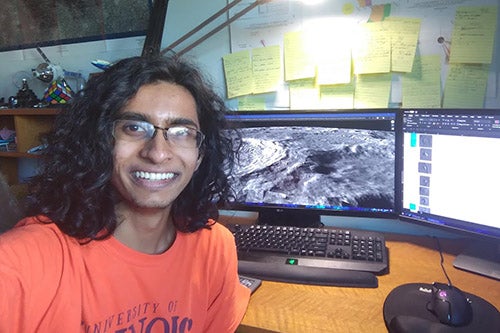Rishi Chandra is a senior studying physics and planetary science, which Chandra describes as the intersection of astronomy and geology, studying planetary bodies, asteroids, and meteorites using data from space probes and lab analysis of extraterrestrial samples. This summer, he conducted research for the NASA Flight Center with support from the Life + Career Design scholarship.
The College of LAS caught up with him to learn more about his experience at NASA this summer.
 Question: What has your internship been like this summer? What’s your specific role?
Question: What has your internship been like this summer? What’s your specific role?
This summer, I’ve been working on a research project under the advising of a NASA planetary scientist at the Marshall Space Flight Center in Huntsville, AL. My project involves analyzing photography sent back by the Lunar Reconnaissance Orbiter, examining the shapes of certain impact craters to understand factors that might be confounding our ability to tell how old different regions on the moon are. My summer has been productive, in spite of the transition to remote work, because my research doesn’t demand any on-site hardware, just a computer with an internet connection and a keen eye for impact craters.
Q: What do you think you’ve gained from your experience at NASA?
My experience working with NASA has given me a lot in the way of professional connections. I’m applying to graduate schools this fall, and one cannot overstate the value of having someone who recognizes your name looking at your application. To that end, my advisor has been a tremendous help in connecting me with people I’d like to work with in the next couple years and pointing out potential advisors who weren’t previously on my radar. Concerning my skill set as an aspiring planetary scientist, the opportunity to work with a NASA scientist on my project has gone a long way toward developing my eye for planetary surfaces, and I’m getting acclimated to the world of planetary science research at a lightning pace, just in time for my search for PhD programs.
Q: What are your ultimate career aspirations?
Ultimately, I aim to do scientific research that contributes to human exploration on and around the moon, and I hope I can do work that inspires future generations of children to enter STEM careers. With that loose goal in mind, I envision my future-self doing research at an academic or government institution, but I won’t discount the possibility that I might find a place in the burgeoning private space industry later on, since it’s growing rapidly and unpredictably.
Q: What is your favorite story or memory from this summer?
My favorite memory this summer was my final presentation of my research. I find it incredibly rewarding to bring all of my work together into one cohesive presentation, and getting the opportunity to share what I did with other students and my friends left me feeling great and inspired to keep doing what I’m doing as I move forward with my career.
Q: We’ll end with a fun one. With it being a research interest of yours, what’s the most interesting thing to you about the moon?
The single coolest thing I know about the moon, and perhaps a major reason I’m dedicating my career to its study is this: most of the moon is bone dry because the hot sunlight boiled all the water into space shortly after it formed ~4.5 billion years ago. But in craters at the North and South pole of the moon, there’s places where the sun never shines, where it’s extremely cold (-400°F!!!) and missions to the moon found multiple lines of evidence for water ice in those craters. In the next couple years, NASA’s Artemis program sending astronauts back to the moon is going to investigate this water ice, and they’re developing technology to do things like melt the ice for growing plants or turning the water into rocket fuel in situ. This opens a pathway to cheaper, more sustainable space exploration, and could allow us to one day use the Moon as a pit stop for Mars missions. The technology developed doing this will also prove useful on Earth, for example in learning to more efficiently utilize water resources in remote, arid regions, or to make better hydrogen fuel cells for clean transportation. Ice on the moon is a revolutionary discovery, and will fundamentally change human space exploration.